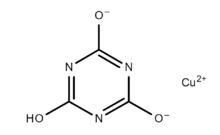Chemistry:Copper(II) cyanurate

| |
| Names | |
|---|---|
| IUPAC name
Copper 6-hydroxy-1,3,5-triazine-2,4-bis(olate)
| |
| Other names
Copper 1,3,5-triazine-2,4,6-triol
| |
| Identifiers | |
3D model (JSmol)
|
|
PubChem CID
|
|
| |
| |
| Properties | |
| C3HCuN3O3 | |
| Molar mass | 190.60434 |
| Appearance | purple powder |
Except where otherwise noted, data are given for materials in their standard state (at 25 °C [77 °F], 100 kPa). | |
| Infobox references | |
Copper(II) cyanurate (C3HCuN3O3) is an organic compound. It has very few uses, and is more often encountered accidentally, rather than actually synthesised.
It is often found when the copper concentration in an outdoor swimming pool is too high. It also occurs with heat pumps due to acid in the insulation, and it reacts with cyanuric acid (which is added as a chlorine stabilizer) to produce copper cyanurate. This phenomenon is called 'Purple Cyanurate', as it discolours the surfaces and the water of the pool to a purple shade.[1]
Synthesis
Copper cyanurate can be created by reacting cyanuric acid with copper oxide.[citation needed]
CuO + 2C3H3N3O3 → C3HCuN3O3 + H2O.
Joanneumite is a rare natural mineral found in bat guano with formula Cu(C3N3O3H2)2(NH3)2 which is an ammine.[citation needed]
By heating copper compounds, such as the nitrate or carbonate with molten urea up to 190°C, they are largely converted to the lavender coloured joanneumite compound.[2] This is dissolved and then recrystallised from a hot strong ammonia solution. If instead a weak (2%) cold ammonia solution is used, the dark purple compound CuC3N3O3H•2NH3 is formed instead.[2]
A green coloured copper cyanurate containing no extra water or ammonia ligands also exists: Cu3(C3N3O3)2.[2]
Applications
Copper cyanurate has no known practical uses. The only place it commonly occurs is as an adverse effect of high levels of copper in swimming pools, and is more commonly seen as a nuisance.[citation needed]
References
- ↑ "Purple Staining, Purple Cyanurate, Copper Cyanurate, PoolMoldSolutions.com" (in en). http://www.poolmoldsolutions.com/purple.html.
- ↑ 2.0 2.1 2.2 Taylor, R. M. (May 1972). "Metal cyanurate compounds formed directly from metal salts and urea". Zeitschrift für anorganische und allgemeine Chemie 390 (1): 85–96. doi:10.1002/zaac.19723900112.
 |

